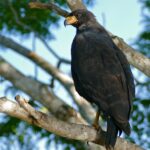Great black hawks are a species of raptor found in the Americas, known for their impressive size and hunting prowess. These majestic birds are fascinating to observe, and one of the key aspects of their life cycle is the timing of their egg-laying. In this comprehensive blog post, we’ll explore the details of when great black hawks lay their eggs and the factors that influence this important event.
The Breeding Season of Great Black Hawks
Great black hawks typically breed during the late winter and spring months, with their breeding season running from late February to late May. This timing is influenced by a variety of environmental factors, including temperature, rainfall, and the availability of their primary food sources.
During the breeding season, these birds will establish and defend their nesting territories, often in areas with a mix of forested and open habitats, as well as near bodies of water. The nest-building process is a collaborative effort between the male and female, with the male typically gathering the materials and the female constructing the nest.
Egg-Laying and Incubation
 Image source: Great Black Hawk by Bernard DUPONT
Image source: Great Black Hawk by Bernard DUPONT
Once the nest is ready, the female great black hawk will lay her eggs, typically between 1 and 3 in number. The eggs are white in color, with brown markings, and they are incubated for around 40 days by both parents, with the female taking on the majority of the incubation duties, especially during the night.
During the incubation period, the parents will take turns sitting on the eggs, ensuring that they are kept at the optimal temperature for the developing embryos. The male will often bring food to the female while she is incubating, helping to ensure that she has the energy and resources she needs to fulfill this crucial task.
Hatching and Fledging
After the 40-day incubation period, the eggs will hatch, and the chicks will emerge. The newly hatched chicks are altricial, meaning they are born helpless and require extensive parental care and feeding. Both the male and female great black hawk will work together to provide food and protection for the chicks as they grow and develop.
The chicks will typically fledge, or take their first flights, around 10 weeks after hatching. However, they will continue to rely on their parents for an additional 5 to 6 weeks, as they learn to hunt and become fully independent.
Habitat and Diet
Great black hawks are found in a variety of habitats, including forests, woodlands, and savannas, often near bodies of water. They are adapted to thrive in altered habitats, such as those with a mix of forested and open areas, as well as those with wetlands or other water sources.
These birds are carnivorous, feeding primarily on small vertebrates such as mammals, birds, amphibians, and reptiles. They are known to frequently include heron chicks and other waterfowl in their diet, making them important predators in their ecosystems.
Conservation Status and Threats
The great black hawk is currently classified as Least Concern on the IUCN Red List, but their numbers are decreasing. They face threats from habitat destruction, particularly the loss of the wetland areas they depend on, as well as disturbances to their nesting sites.
Conservation efforts are underway to protect these birds and their habitats, with organizations like the Peregrine Fund working to monitor and study the great black hawk population. By understanding the details of their breeding and nesting habits, we can better inform conservation strategies and ensure the long-term survival of this impressive raptor.
Conclusion
The great black hawk is a fascinating and ecologically important bird species, and understanding the details of their egg-laying and breeding habits is crucial for their conservation. By exploring the timing of their breeding season, the incubation and hatching of their eggs, and the factors that influence their nesting and feeding behaviors, we can gain valuable insights into the life cycle of these remarkable raptors.
Whether you’re a birdwatcher, a nature enthusiast, or simply someone who appreciates the beauty and diversity of the natural world, learning about the great black hawk and its unique breeding habits is a rewarding and enlightening experience.


